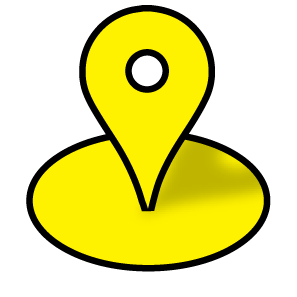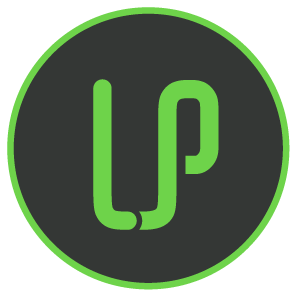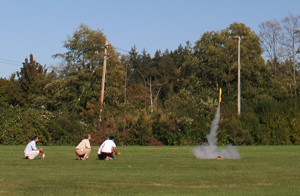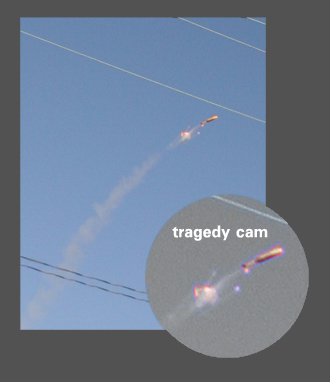Eggnauts — Engineers Launch Model Rockets at UBC
contents
The contest took place at UBC in 2005. The goal was to launch a rocket at least 150m into the air with a payload of an egg and bottle of maple syrup. And — you guess it — the egg had to be returned back to earth in relative safety.
I was first in line to see the egg carnage, which promised to be the best part of the show.
I mean, who wants to see whole eggs landing in relative safety anyway?
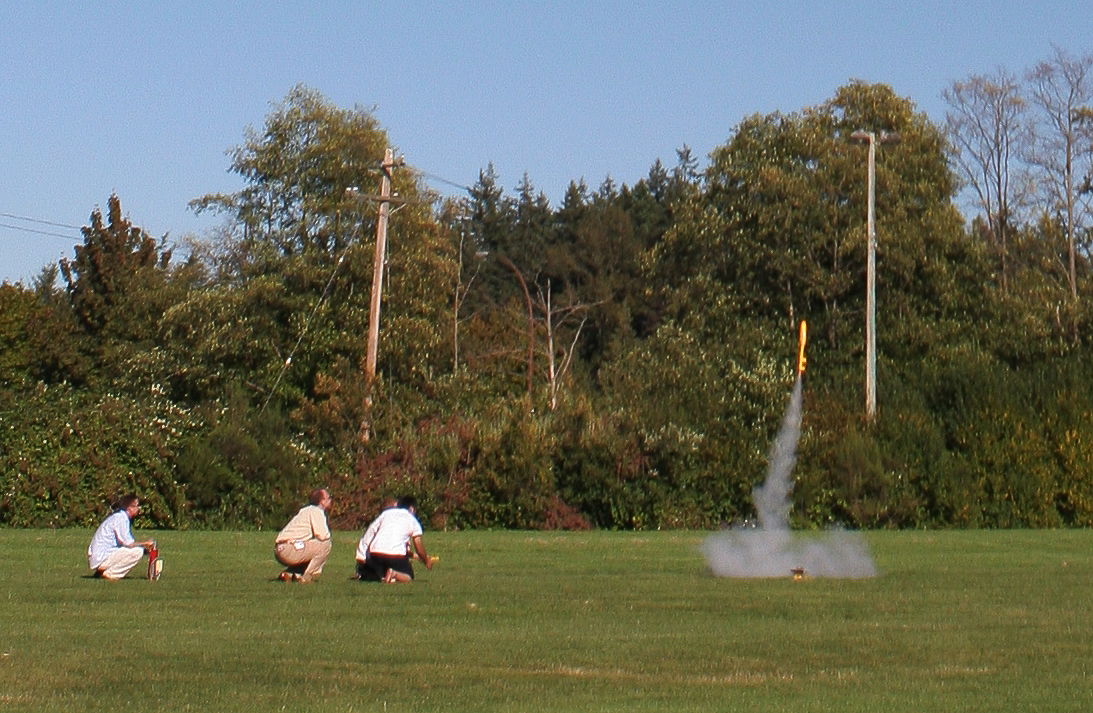
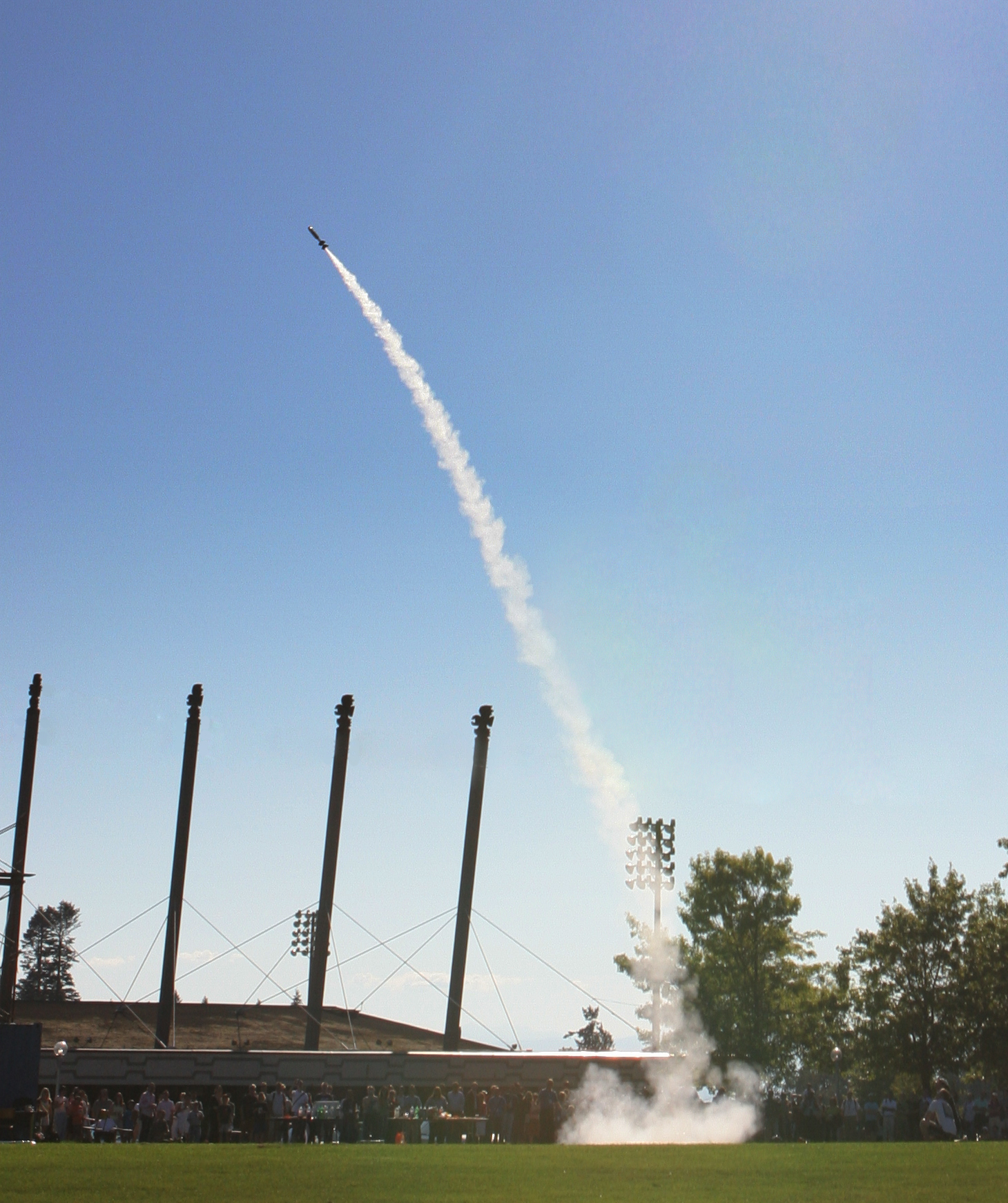
I was well positioned with my camera for the launch. After a few times being told to step even further back — so that I would not get egg on my face, I'm sure — I settled into a position that was both safe and a good lookout.
Unfortunately, from my vantage point I was shooting right into the sun, so the photos are a little bleached out. I also had the 24-70mm f/2.8L on my 20D so I couldn't get good reach. The photos here are 100% crops.
Shooting at 5 fps, I caught the first sign of the plume developing around the rocket as its engines ignited.
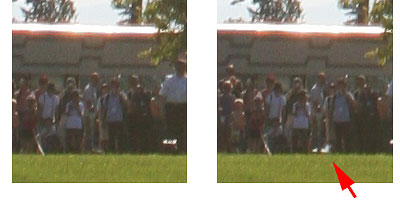
After the second frame, the acceleration was rapid and the rocket lifted off to 2-3 m before my next frame.
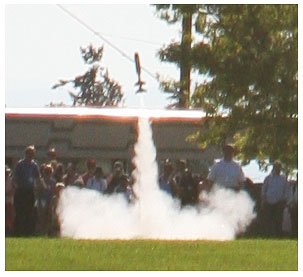
And it was on its way!

And then it just kept going, and going and going. It finally disappeared travelling west. Nobody heard from the egg again.
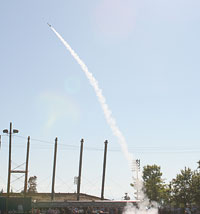

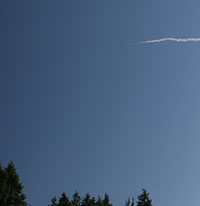
After the first launch I repositioned myself to face south, with the sun at my back. After the excitement of the egg launched into orbit, I could hardly anticipate what came next. I was in for a show so exciting that all remaining launches were promptly canceled. Read on.
Before the launch, I caught the engineers looking over their rocket. Handling it lovingly, they were making sure that the eggnaut and maple syrup were snuggly nestled into the payload canister.
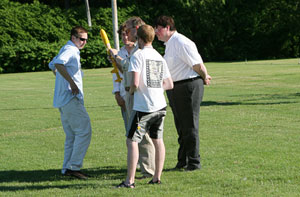
The tension was palpable. Would it launch? Would it reach 150m? Would the eggnaut return to tell the tale without cracking?
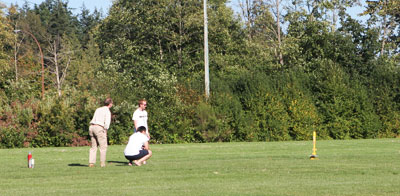
Once again, the shutter flapped at 5 fps as the rocket took off. This time, I caught the start of the plume at just the right time and captured the rocket take off in the first few frames.

The trip started solidly for our eggnaut. The launch was timely, and more importantly, the rocket was travelling vertically - upwards. Would the egg make a career out of it? Just as our hopes were rising, we realized that something was terribly wrong. Shortly after take off, it became clear that the eggnaut was doomed. We didn't want to believe it at first, but it was obvious that the flight plan was taking a turn for the worse.
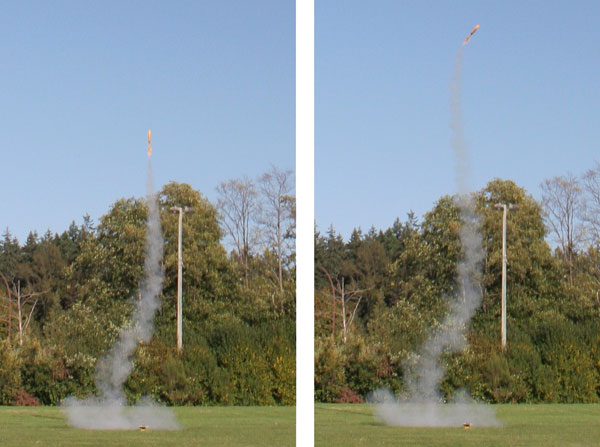
The rocket began to spin wildly. To add, it began to turn to traveling the directly of the shocked onlookers and the parking lot. It was not longer just about the egg anymore. Fear gripped me, but I kept shooting. The next four frames reveal the horrible events that sealed the eggnaut's doom. In the second of the frames, an unplanned explosion is clearly seen. The rocket is undeterred by this, and continues to fly in the direction of the spectators.
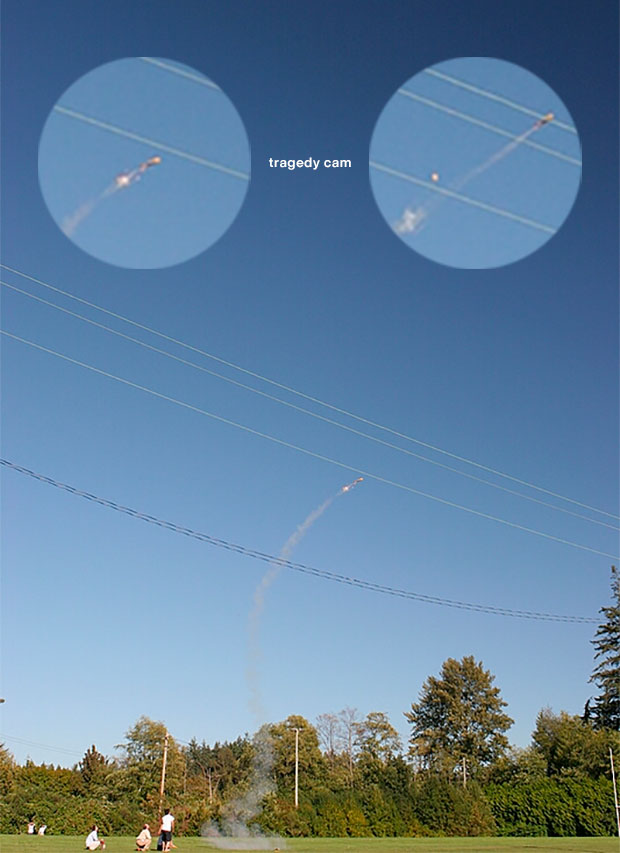
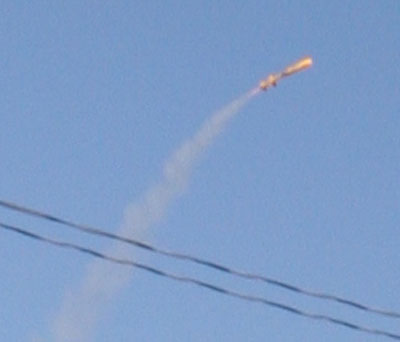
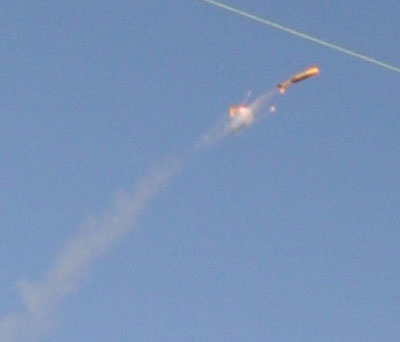
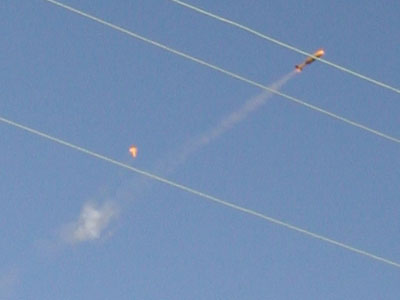
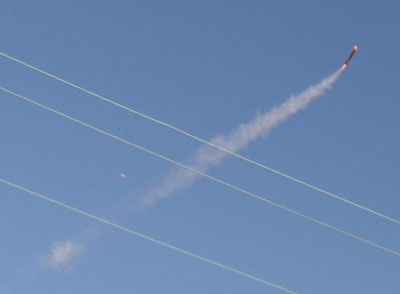
The travel path became more erratic, and only a few seconds later the last booster cut-off. The eggnaut, perhaps still viable, was in free fall. Falling, accelerating - right into the parking lot.
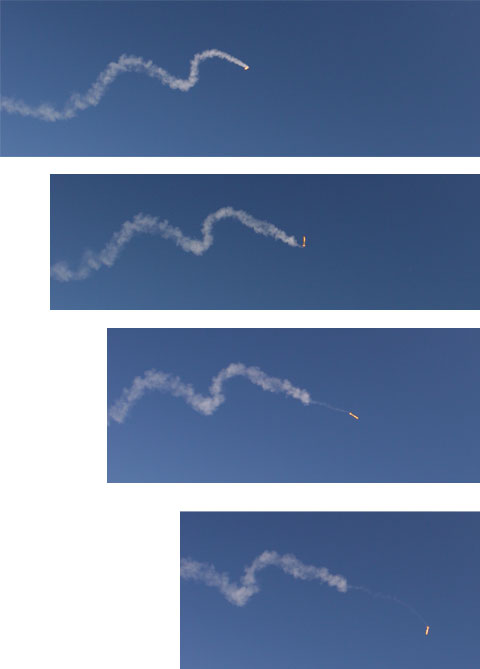
I started running towards the extrapolated crash site, as I heard a thud. When I got there, a small crowd already formed around the impact site. Someone called for an eggdoctor. In my first shot of the macabre, only the parachute, never deployed, is seen. The true extent of the disaster is covered by the figure of solemn child.
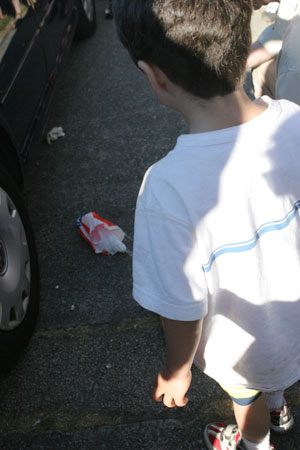
Rapidly, the team of engineers arrived on site. Although the rocket spent about 10 fateful seconds in the air, it only traveled about 30 meters, as the crow flies (which it does much longer).
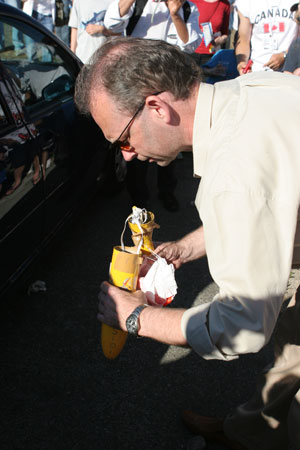
Of course, all eyes were on the contents. Was the eggnaut safe? Perhaps by some earthly miracle, the impact was not severe enough. Of course, even before the rocket payload canister was opened, we all knew that the sickly thud that placed the rocket less than a meter from a car was a mortal hit to our airborne friend.
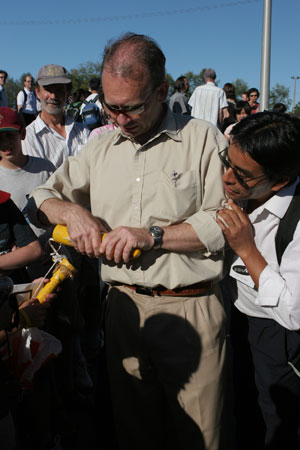
The next photo captures the human moment of tragedy. The team lead finally realizes that nothing survived. The man behind him and to the right bites his lip in disappointment and shock.
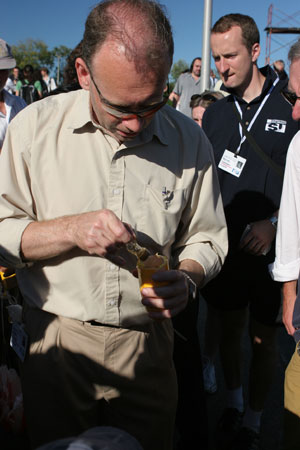
The next photo reveals the payload - now turned into an ogrish paste of eggnaut and maple syrup.
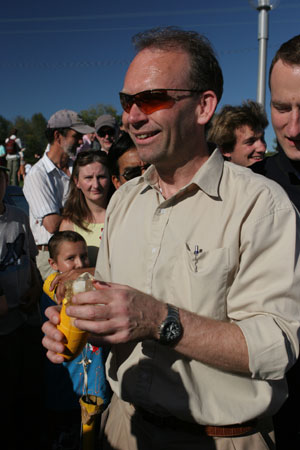
The third team stood by - their launch canceled. Their hearts were heavy with the tragedy of the previous team's horrible flame-out. One of the team members is seen here so distraught that he kneals and leans on his rocket for support.
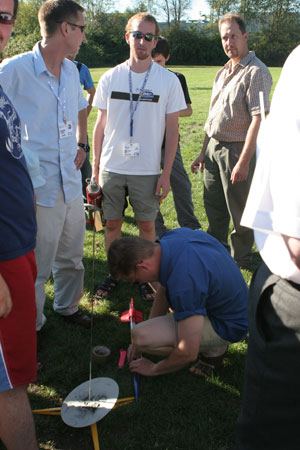
Yet they could not help but imagine - how far would their eggnaut have traveled?
Nasa to send our human genome discs to the Moon
We'd like to say a ‘cosmic hello’: mathematics, culture, palaeontology, art and science, and ... human genomes.



Comparing classifier performance with baselines
All animals are equal, but some animals are more equal than others. —George Orwell
This month, we will illustrate the importance of establishing a baseline performance level.
Baselines are typically generated independently for each dataset using very simple models. Their role is to set the minimum level of acceptable performance and help with comparing relative improvements in performance of other models.

Unfortunately, baselines are often overlooked and, in the presence of a class imbalance5, must be established with care.
Megahed, F.M, Chen, Y-J., Jones-Farmer, A., Rigdon, S.E., Krzywinski, M. & Altman, N. (2024) Points of significance: Comparing classifier performance with baselines. Nat. Methods 20.
Happy 2024 π Day—
sunflowers ho!
Celebrate π Day (March 14th) and dig into the digit garden. Let's grow something.

How Analyzing Cosmic Nothing Might Explain Everything
Huge empty areas of the universe called voids could help solve the greatest mysteries in the cosmos.
My graphic accompanying How Analyzing Cosmic Nothing Might Explain Everything in the January 2024 issue of Scientific American depicts the entire Universe in a two-page spread — full of nothing.
The graphic uses the latest data from SDSS 12 and is an update to my Superclusters and Voids poster.
Michael Lemonick (editor) explains on the graphic:
“Regions of relatively empty space called cosmic voids are everywhere in the universe, and scientists believe studying their size, shape and spread across the cosmos could help them understand dark matter, dark energy and other big mysteries.
To use voids in this way, astronomers must map these regions in detail—a project that is just beginning.
Shown here are voids discovered by the Sloan Digital Sky Survey (SDSS), along with a selection of 16 previously named voids. Scientists expect voids to be evenly distributed throughout space—the lack of voids in some regions on the globe simply reflects SDSS’s sky coverage.”
voids
Sofia Contarini, Alice Pisani, Nico Hamaus, Federico Marulli Lauro Moscardini & Marco Baldi (2023) Cosmological Constraints from the BOSS DR12 Void Size Function Astrophysical Journal 953:46.
Nico Hamaus, Alice Pisani, Jin-Ah Choi, Guilhem Lavaux, Benjamin D. Wandelt & Jochen Weller (2020) Journal of Cosmology and Astroparticle Physics 2020:023.
Sloan Digital Sky Survey Data Release 12
Alan MacRobert (Sky & Telescope), Paulina Rowicka/Martin Krzywinski (revisions & Microscopium)
Hoffleit & Warren Jr. (1991) The Bright Star Catalog, 5th Revised Edition (Preliminary Version).
H0 = 67.4 km/(Mpc·s), Ωm = 0.315, Ωv = 0.685. Planck collaboration Planck 2018 results. VI. Cosmological parameters (2018).
constellation figures
stars
cosmology
Error in predictor variables
It is the mark of an educated mind to rest satisfied with the degree of precision that the nature of the subject admits and not to seek exactness where only an approximation is possible. —Aristotle
In regression, the predictors are (typically) assumed to have known values that are measured without error.
Practically, however, predictors are often measured with error. This has a profound (but predictable) effect on the estimates of relationships among variables – the so-called “error in variables” problem.

Error in measuring the predictors is often ignored. In this column, we discuss when ignoring this error is harmless and when it can lead to large bias that can leads us to miss important effects.
Altman, N. & Krzywinski, M. (2024) Points of significance: Error in predictor variables. Nat. Methods 20.
Background reading
Altman, N. & Krzywinski, M. (2015) Points of significance: Simple linear regression. Nat. Methods 12:999–1000.
Lever, J., Krzywinski, M. & Altman, N. (2016) Points of significance: Logistic regression. Nat. Methods 13:541–542 (2016).
Das, K., Krzywinski, M. & Altman, N. (2019) Points of significance: Quantile regression. Nat. Methods 16:451–452.
Convolutional neural networks
Nature uses only the longest threads to weave her patterns, so that each small piece of her fabric reveals the organization of the entire tapestry. – Richard Feynman
Following up on our Neural network primer column, this month we explore a different kind of network architecture: a convolutional network.
The convolutional network replaces the hidden layer of a fully connected network (FCN) with one or more filters (a kind of neuron that looks at the input within a narrow window).

Even through convolutional networks have far fewer neurons that an FCN, they can perform substantially better for certain kinds of problems, such as sequence motif detection.
Derry, A., Krzywinski, M & Altman, N. (2023) Points of significance: Convolutional neural networks. Nature Methods 20:1269–1270.
Background reading
Derry, A., Krzywinski, M. & Altman, N. (2023) Points of significance: Neural network primer. Nature Methods 20:165–167.
Lever, J., Krzywinski, M. & Altman, N. (2016) Points of significance: Logistic regression. Nature Methods 13:541–542.



